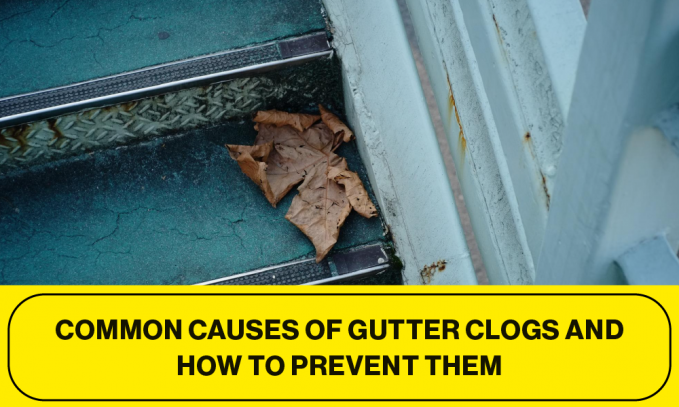A gutter system plays a crucial role in protecting your roof, walls, and foundation from water damage. When debris such as leaves, twigs, and dirt accumulates, gutters can become clogged and stop functioning properly.
Understanding the causes of gutter clogs and learning how to prevent them can help prevent costly repairs and maintain your home’s structural integrity.
In this blog, we’ll explore various causes of gutter clogs, the consequences of unclean gutters, and simple ways to prevent them.
A Complete Guide to Understanding the Causes of Gutter Clogs
Gutters usually clog during heavy rain or fall seasons due to abundant leaves and debris. The main causes of gutter clogs often come down to what ends up staying in your gutters and how often you clean them. Here are the most common causes:
1. Leaves, Twigs, and Dirt
Falling leaves are one of the biggest causes of gutter clogs. During autumn, dry leaves, twigs, and small branches can easily accumulate inside your gutters. Over time, this accumulation can cause water to overflow and damage your siding and foundation.
2. Seeds and Plants Growing in Gutters
Sometimes, small plants grow because of the accumulated dirt and decomposing leaves that create fertile soil. Seeds carried by wind or birds can germinate, leading to a full-blown “gutter garden.”
3. Poor Downspout Alignment
Even if your gutters are clear, an improperly aligned or clogged downspout can prevent water from flowing properly. This leads to standing water in the gutters, which attracts debris and worsens clogging.
4. Bird Nests and Small Animals
Gutters are an attractive nesting and breeding ground for birds, squirrels, and insects. Unfortunately, these nests block water flow and lead to backups, especially during rainfall.
5. Roof Shingle Granules
As your roof ages, the asphalt shingles start shedding tiny granules, which wash down into the gutters and gradually settle at the bottom, forming a sludge that blocks water flow. If not cleaned properly, this accumulation of sludge can lead to gutter clogging.
What Are the Consequences of Unclean Gutters?
Ignoring gutter maintenance can have various consequences, leading to replacement or costly repairs. The consequences of unclean gutters go far beyond just water overflow, which can affect the overall value of your property.
1. Water Damage to Roof, Walls, and Foundation
When gutters overflow, water seeps under roof shingles or into your walls, leading to rot, mold, and structural decay. This kind of damage can compromise your roof’s lifespan and lead to expensive repairs.
2. Foundation Erosion
Clogged gutters allow rainwater to pool around your home’s foundation. Over time, this can erode the soil and cause cracks or shifting in the foundation, which can be very costly to fix.
3. Basement Flooding
Improper drainage is one of the leading causes of basement flooding. If your gutters fail to redirect rainwater effectively, it can leak into your basement and damage flooring, furniture, and electrical systems.
4. Encourage Pest Infestation
Standing water in clogged gutters attracts mosquitoes, termites, and other insects. Additionally, debris buildup provides nesting material for birds and rodents.
5. Reduces Your Property’s Curb Appeal
Overflowing gutters can stain your home’s exterior and make it look neglected. Keeping gutters clean enhances both appearance and property value.
Ways to Prevent Gutter Clogs to Reduce Costly Repairs
Now that you understand the causes of gutter clogs, here are practical ways to prevent them and keep your system running efficiently:
1. Cleaning Gutters Regularly
Schedule gutter cleaning at least twice a year, once in the spring and once in the fall. Homes surrounded by trees may need more frequent maintenance.
2. Installing Gutter Guards
Adding roof gutter covers or guards helps block leaves and large debris from entering the gutters while allowing water to pass through. This reduces cleaning frequency and minimizes the risk of clogs.
3. Checking Downspouts for Clogging and Leaks
Ensure that downspouts are properly aligned and direct water at least three feet away from your foundation. Clean them out during every maintenance session.
4. Trimming Nearby Trees
If you have overhanging branches, trim them regularly to reduce the number of leaves and twigs that fall into your gutters.
5. Inspection After Heavy Storms
Heavy winds and rain can wash debris into your gutters. Always inspect and clear them after a storm to prevent sudden blockages.
The Bottom Line
The most common causes of gutter clogs are leaves, twigs, dirt, and poor cleaning and maintenance, which can lead to severe issues. However, gutters are easy to clean and maintain, preventing water damage and saving on costly repairs. For effective cleaning, repairing, and maintenance of your gutter, you should consider calling a professional.
Sunshine Gutters Pro is an end-to-end gutter service company providing services like gutter cleaning and maintenance in San Rafael and San Ramon. Get in touch to learn more about the causes of gutter clogs and their maintenance.
FAQ’s
What are the most common causes of gutter clogs?
Leaves, twigs, seeds, dirt, and other debris from nearby trees are the most frequent causes of gutter clogs.
Are clogged gutters dangerous to my home?
Yes, clogged gutters can lead to roof leaks, foundation damage, landscape erosion, and basement flooding.
How often should gutters be cleaned?
Gutters should generally be cleaned twice a year, in spring and fall. Homes surrounded by trees may need more frequent cleaning.
How do clogged gutters affect my roof?
Water can back up under shingles, causing leaks, rot, and mold growth, compromising roof integrity.







